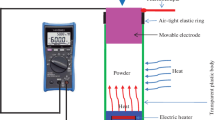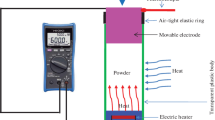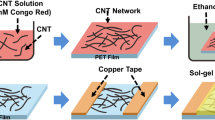Abstract
This work presents design, fabrication, and investigation of carbon nanotube (CNT), orange dye (OD), and graphene powder based multifunctional sensors. The output of the multifunctional sensors is observed as change in resistance and impedance values for an input change in temperature, pressure, and compressive displacement between the sensors electrodes. Using these sensors, temperature variation ranging from 30 to \(65^{\circ }\hbox {C}\), pressure 0 to 0.1 \(\hbox {kgf\,cm}^{-2}\) and longitudinal compressive displacements of 0 to 110 \(\upmu \hbox {m}\) are measured as change in resistance and impedance at two fixed frequencies, i.e., 100 Hz and 100 KHz. An increase in both resistance and impedance of the sensors is observed with increase in temperature. The temperature coefficients of the sensors having resistances \(\sim 470\)\(\Upomega\) and \(\sim 890\)\(\Upomega\) were \(1.0\%\,{}^{\circ }\hbox {C}^{-1}\) and \(1.9\%\,{}^{\circ }\hbox {C}^{-1}\), respectively, when evaluated for temperatures ranging from 30 to \(65^{\circ }\hbox {C}\). For applied pressure 0 \(\hbox {kgf\,cm}^{-2}\) to 0.1 \(\hbox {kgf\,cm}^{-2}\) and displacement 0 to 110 \(\upmu \hbox {m}\) the resistance of the multifunctional sensor decreases 1.3 to + 12.7 times (from 6730 \(\Upomega\) to 5210 \(\Upomega\) and 3410 \(\Upomega\) to 269 \(\Upomega\)) and 3.18 to 7.53 times (2235 \(\Upomega\) to 702 \(\Upomega\) and 6787 \(\Upomega\) to 901 \(\Upomega\)), respectively. With increased thickness of OD layer from 300 \(\upmu \hbox {m}\) to 570 \(\upmu \hbox {m}\), the output resistance and impedance of the sensors as a function of temperature also increased, exhibiting the improved sensitivity, however, at the expense of decreased pressure and displacement response of the sensors. Therefore, the thickness of OD film can be used as a design parameter for a desired sensitivity value to cater a particular application. The proposed multifunctional sensor can be a good candidate to measure temperature, pressure, and displacement of an industrial unit, such as flex bonding head because it offers light weight, simpler design, low maintenance, and eventually low cost.





Similar content being viewed by others
References
J. Terada and T. Nitta, Multi-functional sensor, U.S. Patent 4,378,691, 5 Apr 1983
S. Yao, Y. Zhu, Wearable multifunctional sensors using printed stretchable conductors made of silver nanowires. Nanoscale 6(4), 2345–2352 (2014)
P. Dario, D.E. De Rossi, Composite, multifunctional tactile sensor, U.S. Patent 4,555,953, 3 Dec 1985
Z.-B. Zhao, H. Li, Q.-L. Lu, Y.-L. Li, Y. Jiang, Multifunctional sensors based on silicone hydrogel and their responses to solvents, pH and solution composition. Polym. Int. 66(4), 566–572 (2017)
D. Liu, Q. Wang, X. Liu, R. Niu, Y. Zhang, J. Sun, A multifunctional sensor in ternary solution using canonical correlations for variable links assessment. Sensors 16(10), 1661 (2016)
T.Y. Choi, B.-U. Hwang, B.-Y. Kim, T.Q. Trung, Y.H. Nam, D.-N. Kim, K. Eom, N.-E. Lee, Stretchable, transparent, and stretch-unresponsive capacitive touch sensor array with selectively patterned silver nanowires/reduced graphene oxide electrodes. ACS Appl. Mater. Interfaces 9(21), 18022–18030 (2017)
B. Mahar, C. Laslau, R. Yip, Y. Sun, Development of carbon nanotube-based sensors—a review. IEEE Sens. J. 7(2), 266–284 (2007)
I.V. Zaporotskova, N.P. Boroznina, Y.N. Parkhomenko, L.V. Kozhitov, Carbon nanotubes: sensor properties—a review. Mod. Electron. Mater. 2(4), 95–105 (2016)
C.S. Boland, U. Khan, C. Backes, A. ONeill, J. McCauley, S. Duane, R. Shanker, Y. Liu, I. Jurewicz, A.B. Dalton et al., Sensitive, high-strain, high-rate bodily motion sensors based on graphene-rubber composites. ACS Nano 8(9), 8819–8830 (2014)
Y. Xu, Z. Guo, H. Chen, Y. Yuan, J. Lou, X. Lin, H. Gao, H. Chen, B. Yu, In-plane and tunneling pressure sensors based on graphene/hexagonal boron nitride heterostructures. Appl. Phys. Lett. 99(13), 133109 (2011)
Z. Ahmad, K.S. Karimov, F. Touati, Flexible impedance and capacitive tensile load sensor based on CNT composite. Chin. Phys. B 25(2), 028801 (2016)
M.T.S. Chani, A.M. Asiri, K.S. Karimov, M. Bashir, S.B. Khan, M.M. Rahman, Carbon nanotubes-silicon nanocomposites based resistive temperature sensors. Int. J. Electrochem. Sci. 10, 3784–3791 (2015)
K.S. Karimov, N. Ahmed, M.M. Bashir, F. Aziz, M.Z. Rizvi, A. Khan, M. Tahir, N.A. Zaidi, M. Hafeez, A.S. Bhatti, Flexible resistive tensile load cells based on MWCNT/rubber composites. Pigment Resin Technol. (2015). https://doi.org/10.1108/PRT-06-2014-0047
A. Khan, K.S. Karimov, Z. Ahmad, K. Sulaiman, M. Shah, S. Moiz, Pressure sensitive organic sensor based on CNT-VO2(3fl) composite. Sains Malays. 43(6), 903–908 (2014)
M.T.S. Chani, K.S. Karimov, A.M. Asiri, N. Ahmed, M.M. Bashir, S.B. Khan, M.A. Rub, N. Azum, Temperature gradient measurements by using thermoelectric effect in CNTs-silicone adhesive composite. PLoS ONE 9(4), 1–6 (2014)
K.S. Karimov, u Abid, M. Saleem, K.M. Akhmedov, M.M. Bashir, U. Shafique, M.M. Ali, Temperature gradient sensor based on CNT composite. Physica B 446, 39–42 (2014)
Q. Cheng, J. Tang, J. Ma, H. Zhang, N. Shinya, L.-C. Qin, Graphene and carbon nanotube composite electrodes for supercapacitors with ultra-high energy density. Phys. Chem. Chem. Phys. 13(39), 17615–17624 (2011)
M. Martin-Gallego, M. Bernal, M. Hernandez, R. Verdejo, M.A. López-Manchado, Comparison of filler percolation and mechanical properties in graphene and carbon nanotubes filled epoxy nanocomposites. Eur. Polymer J. 49(6), 1347–1353 (2013)
J. Du, L. Zhao, Y. Zeng, L. Zhang, F. Li, P. Liu, C. Liu, Comparison of electrical properties between multi-walled carbon nanotube and graphene nanosheet/high density polyethylene composites with a segregated network structure. Carbon 49(4), 1094–1100 (2011)
Z.M. Markovic, L.M. Harhaji-Trajkovic, B.M. Todorovic-Markovic, D.P. Kepić, K.M. Arsikin, S.P. Jovanović, A.C. Pantovic, M.D. Dramićanin, V.S. Trajkovic, In vitro comparison of the photothermal anticancer activity of graphene nanoparticles and carbon nanotubes. Biomaterials 32(4), 1121–1129 (2011)
A.B. Oskouyi, U. Sundararaj, P. Mertiny, Effect of temperature on electrical resistivity of carbon nanotubes and graphene nanoplatelets nanocomposites. J. Nanotechnol. Eng. Med. (2014). https://doi.org/10.1115/1.4030018
K.S. Karimov, M.H. Sayyad, M. Ali, M.N. Khan, S.A. Moiz, K.B. Khan, H. Farah, Z.M. Karieva, Electrochemical properties of Zn/orange dye aqueous solution/carbon cell. J. Power Sources 155(2), 475–477 (2006)
K.S. Karimov, M. Ahmed, S. Moiz, P. Babadzhanov, R. Marupov, M. Turaeva, Electrical properties of organic semiconductor orange nitrogen dye thin films deposited from solution at high gravity. Eurasian Chem. Technol. J. 5(2), 109–113 (2003)
K.S. Karimov, T. Qasuria, The use of displacement sensitive organic field effect transistor for telemetry system applications. Measurement 45(1), 41–46 (2012)
H. Pang, Y.-C. Zhang, T. Chen, B.-Q. Zeng, Z.-M. Li, Tunable positive temperature coefficient of resistivity in an electrically conducting polymer/graphene composite. Appl. Phys. Lett. 96(25), 251907 (2010)
K.S. Karimov, H. Senin, I. Qazi, M. Sadrai, Organic semiconductors: conduction mechanisms and some applications, in AIP Conference Proceedings, vol. 1017, pp. 25–34. American Institute of Physics (2008)
D. Fathi, A review of electronic band structure of graphene and carbon nanotubes using tight binding. J. Nanotechnol. 2011, 1–6 (2011)
M.S. Dresselhaus, G. Dresselhaus, P. Avouris, Carbon Nanotubes: Synthesis, Structure, Properties, and Applications (Springer, New York, 2014)
A. Suzuki, M. Tanabe, S. Fujita, Electronic band structure of graphene based on the rectangular 4-atom unit cell. J. Mod. Phys. 8(4), 607–621 (2017)
C.P. Poole Jr., F.J. Owens, Introduction to Nanotechnology (Wiley, New York, 2003)
A. Naeemi, J.D. Meindl, Design and performance modeling for single-walled carbon nanotubes as local, semiglobal, and global interconnects in gigascale integrated systems. IEEE Trans. Electron. Dev. 54(1), 26–37 (2006)
B. Wei, R. Vajtai, P. Ajayan, Reliability and current carrying capacity of carbon nanotubes. Appl. Phys. Lett. 79(8), 1172–1174 (2001)
P.G. Collins, M. Hersam, M. Arnold, R. Martel, P. Avouris, Current saturation and electrical breakdown in multiwalled carbon nanotubes. Phys. Rev. Lett. 86(14), 3128–3131 (2001)
S. Berber, Y.-K. Kwon, D. Tománek, Unusually high thermal conductivity of carbon nanotubes. Phys. Rev. Lett. 84(20), 4613–4616 (2000)
A. Raychowdhury, K. Roy, Modeling of metallic carbon-nanotube interconnects for circuit simulations and a comparison with Cu interconnects for scaled technologies. IEEE Trans. Comput. Aided Des. Integr. Circuits Syst. 25(1), 58–65 (2005)
K.S. Novoselov, A. Geim, The rise of graphene. Nat. Mater. 6(3), 183–191 (2007)
S. Fujita, A. Suzuki, Electrical Conduction in Graphene and Nanotubes (Wiley Online Library, 2013)
K.S. Karimov, K. Sulaiman, Z. Ahmad, K.M. Akhmedov, A. Mateen, Novel pressure and displacement sensors based on carbon nanotubes. Chin. Phys. B 24(1), 018801 (2015)
A.C. Neto, F. Guinea, N.M. Peres, K.S. Novoselov, A.K. Geim, The electronic properties of graphene. Rev. Mod. Phys. 81(1), 109 (2009)
S.D. Sarma, S. Adam, E. Hwang, E. Rossi, Electronic transport in two-dimensional graphene. Rev. Mod. Phys. 83(2), 407 (2011)
M.I. Katsnelson, Graphene: Carbon in Two Dimensions (Cambridge University Press, Cambridge, 2012)
K.S. Karimov, Electrophysical properties of low-dimensional organic materials at deformation. PhD thesis, Department of Heat Physics, Academy of Sciences, Tashkent, Uzbekistan (1993)
E. Eidelman, A.Y. Vul, The strong thermoelectric effect in nanocarbon generated by the ballistic phonon drag of electrons. J. Phys. Condens. Matter 19(26), 266210 (2007)
H. Bässler, A. Köhler, Charge transport in organic semiconductors. In: Unimolecular and Supramolecular Electronics I (Springer, Berlin, 2011), pp. 1–65
M.T.S. Chani, K.S. Karimov, A.M. Asiri, Carbon nanotubes and graphene powder based multifunctional pressure, displacement and gradient of temperature sensors. Semiconductors 54(1), 85–90 (2020)
Acknowledgements
The authors would like to thank the reviewers for their valuable suggestions to improve the manuscript. We would also like to acknowledge the support of CUST, GIK Institute, and Center for Innovative Development of Science and New Technologies of Academy of Sciences, Rudaki Ave. 33, Dushanbe, Tajikistan.
Author information
Authors and Affiliations
Corresponding author
Additional information
Publisher's Note
Springer Nature remains neutral with regard to jurisdictional claims in published maps and institutional affiliations.
Rights and permissions
About this article
Cite this article
Shafique, S., Karimov, K.S., Abid, M. et al. Carbon nanotubes, orange dye, and graphene powder based multifunctional temperature, pressure, and displacement sensors. J Mater Sci: Mater Electron 31, 8893–8899 (2020). https://doi.org/10.1007/s10854-020-03424-5
Received:
Accepted:
Published:
Issue Date:
DOI: https://doi.org/10.1007/s10854-020-03424-5




